MXL 990 USB Mic Review
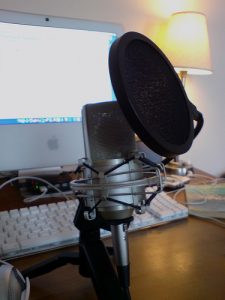 Some professional recording engineers got bitter when cheap Chinese mics got good. Who could blame them? They spent a fortune on fancy mics from Neumann, Blue and AKG. Of course these microphones are still the cream of the crop but inexpensive offerings from companies like MXL came dangerously close. Models seemed hit or miss with MXL. However, the message was clear: you don’t need to take out a second mortgage to sound good.
Some professional recording engineers got bitter when cheap Chinese mics got good. Who could blame them? They spent a fortune on fancy mics from Neumann, Blue and AKG. Of course these microphones are still the cream of the crop but inexpensive offerings from companies like MXL came dangerously close. Models seemed hit or miss with MXL. However, the message was clear: you don’t need to take out a second mortgage to sound good.
Design and Electronics
The MXL 990 USB is the USB compatible version of the 990. It looks identical to its brother but has completely different electronics. Inside there is a little USB audio interface, allowing you to hook it up to any computer without hassling with mixers, preamps, etc.
Its design was kept clean instead of opting to integrate hardware dials and switches. Personally, I like to do my tweaking with software for two reasons. Firstly, a knob and a few switches don’t offer comprehensive control anyhow. Secondly, I like road-worthy gear. Flimsy knobs are the first thing to go missing or get damaged.
What You Get
If you manage to get the kit version, this mic comes in a pretty slick foam-padded case. I was expecting to find a shock mount inside as the non-USB 990 comes with a nice one. Unfortunately there is a USB cable in the place where the shock mount should be. Does anyone need yet another USB 2.0 cable? At least this will ensure you don’t forget it to the gig. Also inside the case is a mic stand adapter. You can also use the included desk tripod if you are a podcaster or plan on recording while sitting down.
Software Woes
In theory, drivers work with either Windows or Mac. This is the area where budget manufacturers like MXL fall down. Smaller companies seem to have trouble keeping up with changes in the software world. I didn’t have problems besides one mysterious crash in Windows 7, but I’ve heard reports that this mic doesn’t play nice with some computer setups.
MXL definitely needs to update their software installation instructions. At this point only XP and Leopard are covered, both of which are long in the tooth as far as operating systems go.
Sound Quality (and Noise) Report
According to MXL, the diaphragm is “6 micron 20mm gold-sputtered.” Most of this bit is over my head, but I can tell you that a 20mm diaphragm is a generous size for a USB microphone. Larger diaphragm mics produce a deeper, richer sound.
Sound quality was crisp and clear. A friend had a nice set of congas in our jam space so I just had to see how well the 990 would reproduce such sounds. Overall it did a pretty good job in stereo besides the fact one side was stronger than the other. MXL definitely needs to work on consistency.
MXL tends deliver pretty well in this department. However, another common theme is noise. Compared with similar mics in this price range I found the 990 USB noisier than it should be. I felt like I couldn’t get gain levels as high as I liked because I dreaded increasing the noise floor.
Review Verdict
The MXL 990 is a good USB mic, and a solid contender a few years ago. Currently there are more than a few better options so it is hard to recommend it. Both the Blue Yeti and Audio-Technica AT2020 are better microphones at a similar price.
I did like the sweet case for transport. However the fact they left out the shock mount is puzzling to say the least. What kills this mic for me is the crappy software. The last thing I want to do with a USB microphone is dink around with technical issues. It was supposed to be “Plug-and-Play”, remember?


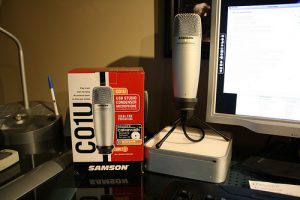 The Samson CO1U is a staple in the podcaster’s arsenal. Since it’s been out for several years it has been thoroughly time-tested. Often experienced podcasters recommend it due to its reliable track record and performance. For many, this is the first USB microphone they’ve ever owned. There is an urge in technophiles like myself to always look to the latest, assuming it is the greatest. I’m admittedly late to the C01U party but felt the need to review it. Clearly, this mic is still relevant and will be for years to come.
The Samson CO1U is a staple in the podcaster’s arsenal. Since it’s been out for several years it has been thoroughly time-tested. Often experienced podcasters recommend it due to its reliable track record and performance. For many, this is the first USB microphone they’ve ever owned. There is an urge in technophiles like myself to always look to the latest, assuming it is the greatest. I’m admittedly late to the C01U party but felt the need to review it. Clearly, this mic is still relevant and will be for years to come.

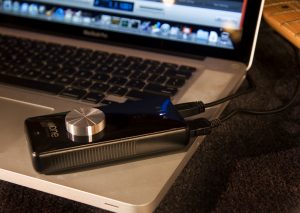 Technically the Apogee ONE can’t be thought of as a USB microphone; it isn’t a USB interface either. It is a hybrid of both.
Technically the Apogee ONE can’t be thought of as a USB microphone; it isn’t a USB interface either. It is a hybrid of both.

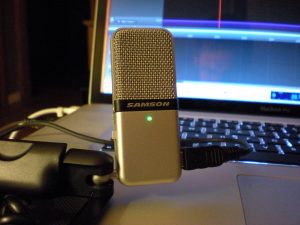 The Go Mic is part of a new breed of micro USB microphones that clip on the top of notebooks. It’s Samson’s answer to Blue’s Snowflake that was released before it.
The Go Mic is part of a new breed of micro USB microphones that clip on the top of notebooks. It’s Samson’s answer to Blue’s Snowflake that was released before it.

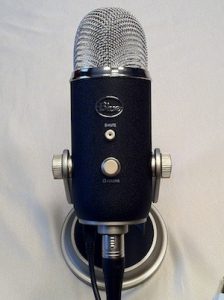 There is one limitation common to USB mics that has me reaching for an old fashioned XLR microphone: the sample rate. Blue’s original Yeti records at 16bit/48 kHz. That is ideal for streaming content on the Web via podcasting or YouTube videos. For music or more demanding applications it falls short. Anyone making records in 16-bit isn’t thinking ahead. Inevitably high-res, 24-bit digital downloads will be the norm in the future.
There is one limitation common to USB mics that has me reaching for an old fashioned XLR microphone: the sample rate. Blue’s original Yeti records at 16bit/48 kHz. That is ideal for streaming content on the Web via podcasting or YouTube videos. For music or more demanding applications it falls short. Anyone making records in 16-bit isn’t thinking ahead. Inevitably high-res, 24-bit digital downloads will be the norm in the future.
